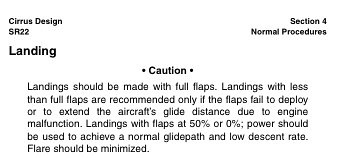Nate,
I was hoping you would chime in here. I knew you fly a STOL 182. I appreciate the great advice!
David
I guess I'll say this... I've got 300 hours in the Robbie and I still wouldn't say I'm convinced I know just how slow it can safely fly. I've played with the low end of the envelope but even I'm chicken to pull it off the ground at the speeds it'll actually fly at. I've probably done their "emergency" Flaps 30 takeoff 20-25 times just to do it, and it's a non-natural feeling takeoff way behind the power curve.
I've gotten close, but just the time it takes to pull the yoke back on a Flap 30 takeoff, you'll be 5 knots over the book CAS number for rotation. If you pull before that you'll be on two wheels and probably drag the tail. It's a timing thing.
Landing, it'll land so bloody slow you can amaze yourself that there's enough air to fly at that speed.
The quickest way to learn how slow -- is to go up high and ease up to a power off stall from a glide.
Set up best glide and then take exactly 5 knots slower one mental notch at a time. Keep slowing. Arms getting tired yet? Trim. Keep slowing... Trim again. Keep slowing.
In mine, it let's me know when it's "done flying" by dropping the nose about 15-20 degrees and RESUMING flying. It doesn't have a tendency to drop a wing or try to head for a spin. I can (and have demoed this for others) lock my arms around the yoke and hold it all the way back and it'll just porpoise, going from about 500 FPM down to 1500 FPM down in a long phugoid oscillation all the way to Terra Firma if you were to let it.
Now release just enough back pressure to hold a descent without the oscillation. It's flying now. And there's how far you need the yoke back power-off and how much trim for a safe slow glide. That's also the speed to set up to land in what most would call a "full stall" landing. If you pull, it'll nose up once and then drop the nose.
Now look at the ASI. All that stuff about calibrated airspeed is no joke in a STOL airplane is it?

(it's going to read a lot slower than you think.)
During that whole test, make sure the radios are quiet and LISTEN to the airframe and air sounds. It's not a common powered flying habit, but a little time in a glider thermalling trains the brain to do it.
My particular aircraft makes a specific noise when the stall fences start working hard. They "sing" with a high pitched vibration is the best way I can describe it. I mentioned this once and David White confirmed his STOL 172 also did it. I can't speak for yours, other than to say "listen and see". In mine it's a big hint that you're WAY behind the power curve (at this altitude especially) and the drag is going to build up massively if you pull any more.
I mention it because it can give you a way not to fixate on the ASI so you can look outside to do the landing.

The other thing to do in the practice area is good old power on slow flight. Find out roughly how much power you need to level off and hold it with full flap. (I've got 40. I don't know what you have.)
Start at approach speed and do the same slowing up drill, 5 knots at a time. You'll get to the stall horn. Keep going. Eventually it'll quit flying and give you lots of warning beforehand. Recover if she does anything squirrelly. If not, release just enough back pressure and maybe reduce power to set up a 500 FPM full flap power on glide. Note again the ASI (it'll look more normal but still seem low).
Now add whatever safety margin you like, and you have your general power setting and horizon picture for a power on approach the speed the airplane likes. It'll be WAY slower than 80.
(You can also do this partial flap for his weird insistence on that.)
Okay. Now you know exactly how it behaves. But you have a boss...
So... if boss wants 80, fine. You now know how far between 80 and the REAL landing/stall speeds of that particular airframe are now, and you can adjust mentally.
Mentally you're "flying 80" until the runway is made, then you'll work on FLYING down to the runway while slowing, power off, and TRIMMING the power change, and FLYING along at the slowing airspeed until the energy all bleeds away from drag. When you see the speed getting down there close to your numbers you saw at altitude, now you can start to "let it land".
If you're set up looking decent for landing on the numbers at 80, you won't really be close to letting it land until about the 1000' marker or that far down without markers if the runway doesn't have them. It's a "waste" of 1000' but it'll keep the chief pilot happy. Ha.
After a bit of practice you can come over the numbers, go to idle, fly smoothly down to a few feet off the ground, slowing up, and then add a bit of power to extend to about 200' before the turn-off you want, and close the throttle there, land and turn off. Heh. Especially with full flaps. It'll just "sit right down" when you close the throttle smoothly if you're a foot off the ground and at the right speed. Usually while the throttle is still sliding aft if you got it just right. Fun stuff.
Thong that up makes me want to go to the airport and go flying!!!



